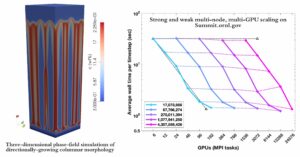Tusas, a novel open-source phase-field simulation framework, represents a superior tool for studying solidification dynamics and microstructure formation in heterogeneous metal alloys under extreme processing conditions such as additive manufacturing (AM). It is purposely designed to leverage hierarchical parallelism on emerging heterogeneous hardware and architectures. Tusas will offer potential solutions toward alloy, process, and microstructure search windows to manufacture AM parts with desired properties and will enable materials scientists to improve material quality, decrease processing time, and minimize manufacturing costs. The Tusas approach, which leverages modern algorithms, discretization, and a high-performance parallel approach, provides a robust route for simulating materials microstructures that will more accurately complement related experimental studies than existing mesoscale tools. Their work was published in the September 2021 issue of the Journal of Computational Physics.
Tusas’s developers demonstrated the framework’s ability to scale both strongly and weakly with up to 4 billion unknowns on thousands of GPUs using benchmark phase-field simulations on Summit (Oak Ridge National Laboratory) and Sierra (Lawrence Livermore National Laboratory). Their phase-field method flexibly addresses multiple physical variables including composition, anisotropy, phase, temperature, orientation, and stress, fully coupled as a set of nonlinear partial differential equations on high-resolution meshes. Tusas improves time-scale challenges with implicit time integration, mitigates length-scale challenges with finite element spatial discretization methods, and leverages the Trilinos library and JFNK (Jacobian-free Newton-Krylov) nonlinear and GMRES (generalized minimal residual method) linear solvers for improved algorithmic efficiency and parallel scalability. As a modular object-oriented framework, Tusas supports a variety of easily coupled phase-field model equations.
By utilizing Kokkos, the Trilinos library, MPI, and CUDA, Tusas uniquely targets emerging exascale architectures. The researchers are using the Tusas framework to perform industrial-scale massively GPU-parallel 3D phase-field simulations of directionally solidifying dendrite materials. They also plan to characterize the large-scale long-time evolution of microstructural characteristics relevant to exascale applications. Tusas is being prepared for deployment on Frontier and other next-generation systems. Tusas has been selected for a 2022 INCITE allocation award, through which the developers will simulate full melt pool microstructure evolution in realistic additive manufacturing environments on Summit.
Supriyo Ghosh, Christopher K. Newman, and Marianne M. Francois. “Tusas: A Fully Implicit Parallel Approach for Coupled Phase-Field Equations.” 2021. Journal of Computational Physics (September).



